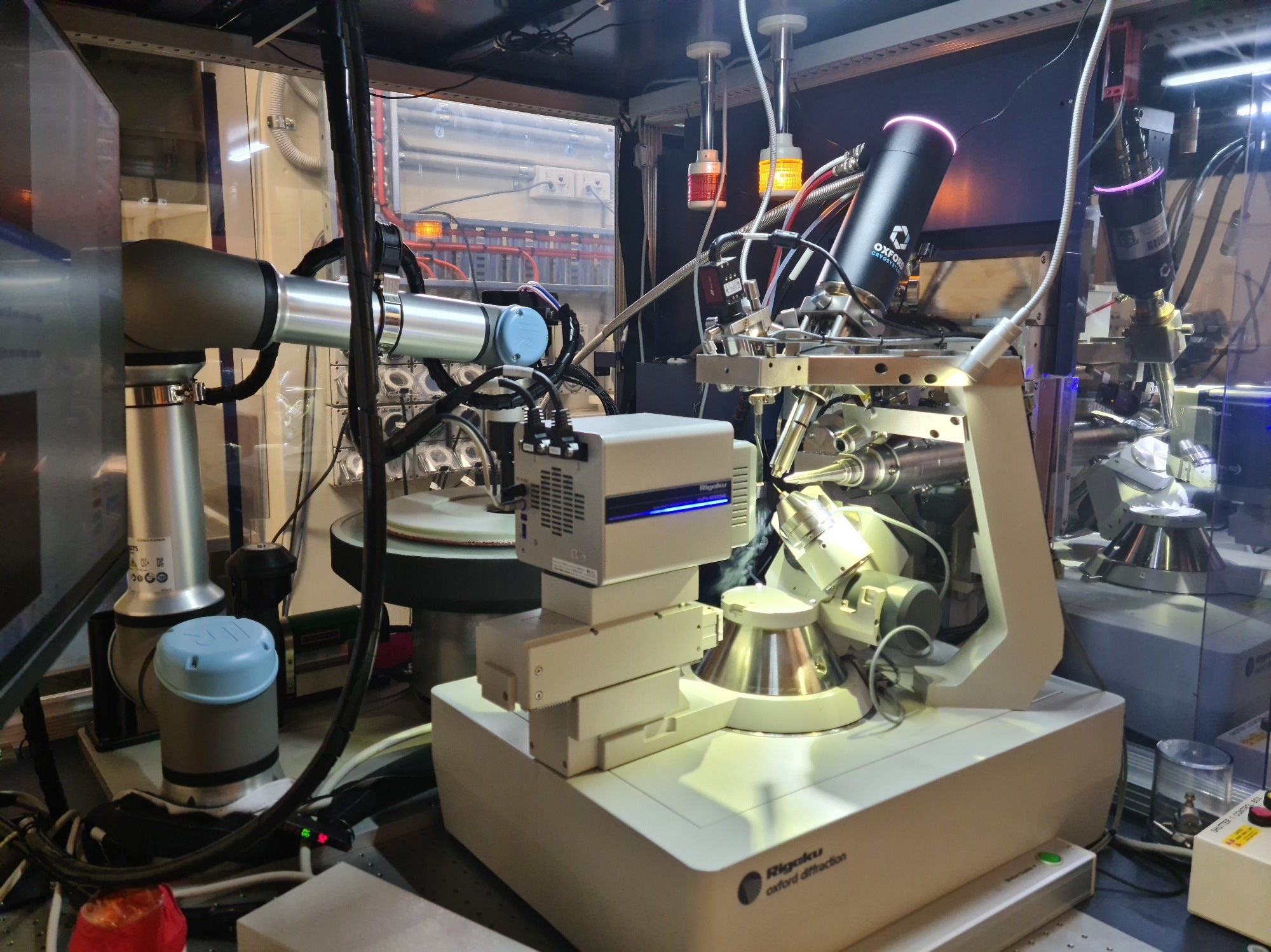On June 13, The University of Sydney’s, Sydney Analytical, proudly opened their new high performance single crystal X-ray diffraction facility. Befitting of this world class facility, the newly installed Synergy Custom, from Rigaku Oxford Diffraction, is one of the most powerful and comprehensive systems in the world.
Custom designed for their research requirements, the new system features a high flux X-ray source, sample loading robot, dual port configuration and latest generation hybrid photon counting (HPC) detectors. This versatility will see the instrument serve researchers from multiple disciplines, such as molecular biology, structural biology, chemistry, chemical engineering, pharmacy and medicine, well into the future.
 Figure 1. One side of the Rigaku Oxford Diffraction Synergy Custom featuring sample loading robot, cryo sample handling and HyPix 6000HE HPC detector.
Figure 1. One side of the Rigaku Oxford Diffraction Synergy Custom featuring sample loading robot, cryo sample handling and HyPix 6000HE HPC detector.
Sydney Analytical is the University’s flagship facility for chemical, biological and materials analysis. They maintain instruments across several locations to serve cutting-edge research. The new Rigaku Oxford Diffraction Synergy Custom replaces an older system and will better serve research into areas such as macromolecular crystallography, MOFs, functional materials, catalysts, anion receptors, inorganic materials, organic chemistry and charge density studies
The new system is powered by a high flux rotating anode X-ray generator, with a unique combination of copper and silver sources. It also features a dual port configuration allowing for experiments to be run on both ports simultaneously, which can cater for completely different experiments. On one side there the is a 96 well-plate screener, ACTOR 2 sample handling robot for maximum throughput and unattended operation, cryogenic sample facility and HyPix 6000HE HPC detector. The other side allows for novel high pressure, ultra-low temperature experiments (down to 28 K) and features a HyPix Arc-150 HPC detector. Any crystal structure collected by the system can be elucidated using Rigaku’s industry-leading CrysAlispro software. With X-ray analytical power second only to the synchrotron, the new system also allows researchers to reduce the number of samples that need to be sent to the synchrotron through better optimisation and even avoiding the need in some cases where the data generated is of high enough quality.
Present at the opening were key personnel from Sydney Analytical including Professor Margaret Sunde (Academic Director), Professor Chris Ling (Deputy Director), Dr. Peter Southon (Operations Manager), Dr. William Lewis (Facility Manager, X-ray techniques) as well as Prof. Cameron Kepert from the School of Chemistry who was instrumental in securing funding for the purchase of the instrument and many other staff members and researchers. Also present were Richard Trett and Peter Airey from AXT PTY LTD, Rigaku Oxford Diffraction’s distributor in Australia and responsible for the installation, commissioning and maintenance of the system.
 Figure 2. (L to R) Cameron Kepert, Peter Rutledge, William Lewis, Peter Southon, Richard Trett, Peter Airey, Chris Ling and Margaret Sunde.
Figure 2. (L to R) Cameron Kepert, Peter Rutledge, William Lewis, Peter Southon, Richard Trett, Peter Airey, Chris Ling and Margaret Sunde.
Speaking on the decision-making process that led to the selection of the Rigaku Oxford Diffraction Synergy Custom, X-ray Facility Manager, Dr. William Lewis said, “The system supports significant high-end science ranging from macromolecular samples, to framework materials and solid state compounds for a variety of research areas. The combination of a high brightness Cu source for routine and macromolecular samples and the short wavelength Ag source for high pressure, diffuse scattering and PDF measurements was key in our decision to go with this system.”
When asked about what new capabilities the system brought to the facility, Dr. Lewis replied:
“The high brilliance copper source allows significantly smaller crystals to be investigated, and in combination with the fast detectors and goniometers, also allow significantly faster data collection compared to previous infrastructure, greatly improving throughput. The plate screening attachment provides a capability that was previously unavailable, allowing crystallographers to screen crystals in situ, without having to go through the sometimes laborious process of mounting the crystals. The high energy silver source improves the range of data collected for high pressure, charge density and total scattering experiments, and also significantly speeds up these experiments.”
Dr. William Lewis, X-ray Facility Manager.
Chief Investigator on the grant proposal that led to the acquisition of the system, Professor Cameron Kepert, went further to say, “this is a tremendously exciting instrument to have and it will support numerous researchers across numerous faculties and bring these researchers together in ways that haven’t been possible previously.”
Richard Trett, AXT’s Managing Director added, “this is a very significant installation for the University of Sydney, Rigaku Oxford Diffraction and AXT. We are extremely proud that we have been able to help bring the whole project together and look forward to seeing the fantastic research that it will enable”.
“As one of the most comprehensive and powerful single crystal diffractometers in the world, this installation shines a light on the importance of crystallography and the strength of Australian research. We are grateful to the University of Sydney for recognising the capabilities of our instruments and proud they have put their trust into our XRD instruments for over 10 years”.
Dr. Mark Benson, Head of Single Crystal Business at Rigaku Oxford Diffraction.
The University of Sydney and Sydney Analytical are grateful to the Australian Research Council (ARC) and the Linkage Infrastructure Equipment and Facilities (LIEF) scheme that made this instrument acquisition possible.